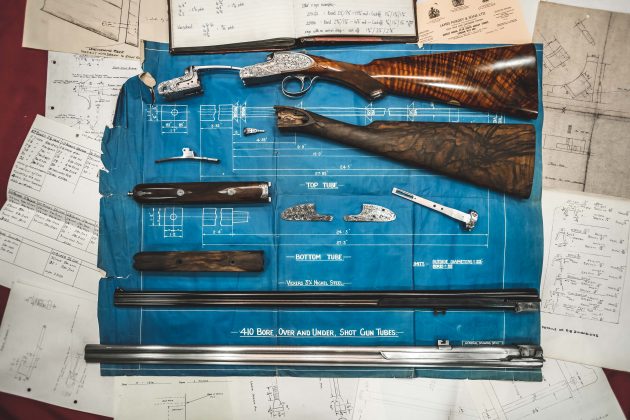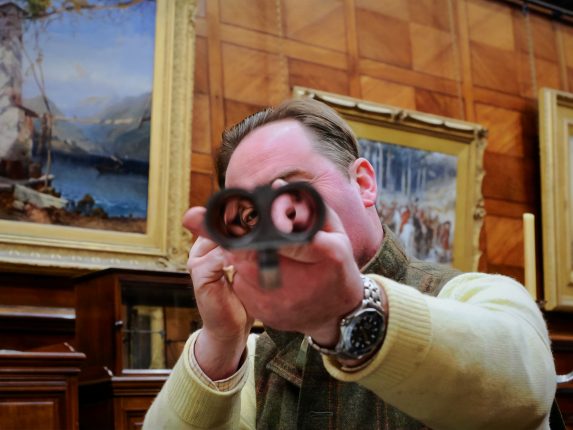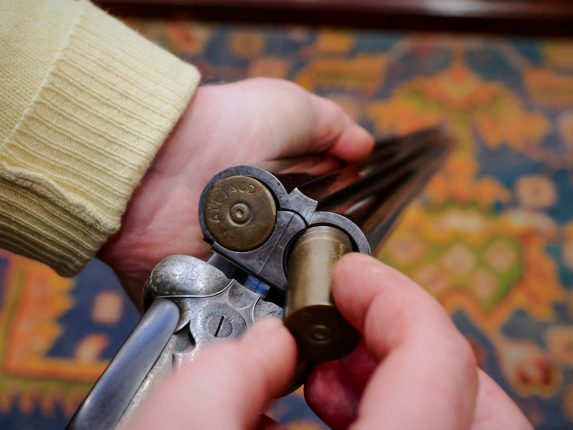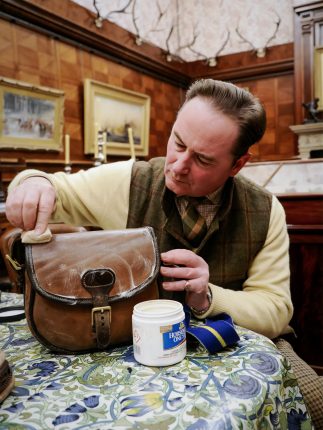Affording proper care and attention to our shooting kit will pay dividends in the long run, keeping it safe, reliable and rust-free, says Neil Cross
All good soldiers and all good shots know that care and maintenance of one’s arsenal is of paramount importance but never more so than during lulls in activity. Although our lives may not always depend upon it, the proper care and attention to our guns and equipment will pay dividends in the long run, and it is surprising how many fine guns get neglected entirely during the close season. Owners of vintage cars would never think of laying up their machine for months at a time and then expect it to work faultlessly and at pace when next it was needed. This analogy may be flawed in the fact that cars are much more complex beasts than guns but the principles are similar. A classic British game gun may have provided wonderful service for more than a century and with minimal care and maintenance will continue to do so for another one. However, most of its components will have been handcrafted by a master of the trade at some magical bench in Birmingham or London, and this very fact means that springs, joints and sears will not be as uniform as the computer-created items of today. Most of us will have either experienced or witnessed mechanical malfunction during a shoot and, even if it’s just one ejector, it can ruin an enjoyable (and perhaps expensive) day in the field.
WHY YOU SHOULD CLEAN YOUR GUN REGULARLY
Modern guns are far from exempt when it comes to gremlins and component failures, and although they are highly developed and robust in their construction, it still pays to keep them in tip-top condition. Deploying with a hitherto completely reliable gun that suddenly stops firing one barrel in the middle of the second drive is more than just a nuisance. The tiniest aberration in a gun’s performance has a profound effect on confidence and technique; it will start to interrupt your accuracy and enjoyment almost immediately. Once a gun has failed to fire or, worse, performed a startling double-discharge, the shooter’s faith in it evaporates quickly and a flinch of anticipation develops. It is actually much wiser to sleeve the gun at once, put it out of use and excruciatingly seek out the generosity of your host and the loan of a fresh gun. Again, this will probably not fit and will cripple your already-dented confidence as you stride out to the third peg of the day with the gun-bus banter still ringing in your ears. At this stage you will feel like Bateman’s ‘The Man Who Failed to Service His Sidelock’.
All this might cause a bit of ribbing and embarrassment; however, the serious issue is safety. A broken ejector is one thing but a detached rib, bulged barrel or discharge on closing can be catastrophic in terms of safety and all can be avoided with proper care and inspection of the guns prior to use. Most of us were brought into shooting by being ‘allowed’ to clean the guns and pluck the birds after a shooting day when we were children. For me, this provided an introduction to some of the most pleasurable activities and aromas available to a youngster, and they have never left me. I still adore the smell of a gun case when it is first opened after the gun has been used.

The heady mix of aged Young’s .303 oil, burnt powder and musty baize is undoubtedly my favourite scent and can only really be improved by the addition of a puff of Cuban cigar smoke. It instantly takes me back to the days of learning how to disassemble and clean my father’s guns while he was enjoying a dram with his friends in another room. This basic level of postshoot maintenance must not be seen as a chore but rather as a part of the day itself. Hunting people would never dream of abandoning tack after a day in the field and the same should apply to guns. As soon as the dog is fed and comfortable, the guns must be thoroughly dried (slowly and never on the Aga or by the fire) then carefully wiped over with your hereditary oily rag. As Sir Joseph Nickerson counselled in A Shooting Man’s Creed: ‘Any gun, whatever its value, must be cleaned meticulously after shooting or at least pulled through and cleaned as soon as possible afterwards. One cartridge can foul and corrode the barrels as much as five hundred if its remains are not quickly removed. Any water, leading to rust, can be extremely damaging and must be removed the same day – the sooner the better – and replaced by proper gun oil. A feather is often useful for drying parts which are not easily accessible and for putting oil there. Thorough cleaning is especially important if you have been wildfowling and your gun has been exposed to the action of salt, which is extremely corrosive.’
This après-shoot regime should comprise not just a full inside-and-out clean but also a diligent inspection of your gun’s parts. Check for ‘headache’ or play in the joint and any unusual sounds when closing the gun. Ribs can be checked for any looseness and barrels for any dings, which will soon become big and costly problems. Bores seldom fail to pitting these days but it is still good practice to check them for any imperfections.

Macdonald Hastings put it clearly in his seminal work, The Shotgun, when he advised that ‘the care of guns is much simpler now than before the coming of non-corrosive ammunition… The law of the gunroom has not changed. Ideally, the gunner ought to have a rack of rods fitted with oily mops, wire brushes and card-headed ones to clean the barrels. An aerosol, filled with Young’s excellent cleaner, is ideal to give a light squirt under the blades of the triggers and down the gutters on both sides of the ribs where rust can be insidious.’
Times have changed but the basics remain the same. Thorough drying, light oiling, polished bores and conservative use of lubricating oil, where required, will all keep the gun sound, and Hastings’ closing advice drove his point home: ‘Make sure you learn… that there is no short-cut to beauty treatment. Guns must be thoroughly cleaned… you must see it through. When you think that the barrels are clean, study them through the muzzle-end until you find they are free of streaks and shine moon-bright to your eye. The cosmetics of your gun are not the least of its charms.’
MAINTENANCE AND SERVICING
The next issue is that of close season deep maintenance and servicing. This is perhaps the equivalent of a main-dealer service for your car and needs to be both properly planned and budgeted for. However, if your guns are old and handmade, there really is no substitute for returning them to their maker for some periodic TLC. There are plenty of gunsmiths capable of servicing fine guns but stick with one you know and trust. There is nothing more irritating than finding the gun returned with chewed screw-heads. Modern guns might not require such regular expert servicing but it is still good practice to put them in for periodic overhauls by approved technicians in order to maintain peace of mind and prolong their lives in the field.

The question of how regular and how thorough this servicing should be is best answered by a professional. Dr Nicholas Harlow, Purdey’s gunroom manager, advises: “At the end of the Season, particularly if you have been shooting in the wet, we strongly recommend getting your gun seen by a professional gunsmith. Much like an MOT on your car, it will allow them to highlight issues that might not be immediately apparent, so that they can be addressed. In catching them early, this can sometimes mean that the repair work is less expensive, particularly when the barrels are coming loose on the action. At the very least it will mean that the action is given a proper deep clean and any dirt that has built up can be removed. It is also worth doing in February or March. Woe betide the gun who puts it off to July or August.”
Harlow also stresses that when the guns are put away for the summer, a light coat of protective oil is applied and snap caps are inserted so that the springs can be eased during storage. This sage advice is often forgotten but when old springs are kept under pressure for months at a time, it is obvious that they will become more prone to failure during the early part of the Season. When the time comes to get the guns out once more, always try to remember that the snap caps will be ejected, so open the gun in a suitable place to avoid any collateral damage.

LOOKING AFTER LEATHER
In addition to a sound cleaning and maintenance regime for our guns, it is also wise to ensure cartridge bags, gun slips and belts are suitably cared for too. A leather cartridge bag will serve generations of the same family faithfully if properly looked after. Again, this becomes more important after the sort of filthy weather we’ve had this Season and, as with the guns, moisture is the enemy of leather. Godfrey Morris is a previous Master Saddler to the King’s Troop Royal Horse Artillery and now runs Crowncraft Leather, where he produces the finest bespoke leatherwork, including cartridge bags and sporting requisites. He is unambiguous in his views on maintaining leather goods in top condition.

Morris advises using “a damp cloth to sponge off mud and grease, then allow the leather to dry naturally before applying saddle soap or leather balm. If the leather has become wet, it is a good idea to towel-dry it as wet leather can stretch and the rivets inside could rust. If leather is dried too quickly – by a radiator, for example – it can become very hard. Once leather is dry, apply a leather conditioner and let it soak in before applying another layer. Leave it overnight and then polish off the next day.”
This might all sound obvious but our guns and leatherware are prized possessions, worthy of care and attention. They will not only last longer and provide additional years of safe and stress-free use if they’re properly cared for but will also reward their owners with that glow of good maintenance and, in the case of leather, a warm patina that all adds to the pleasure of using them in the field.




